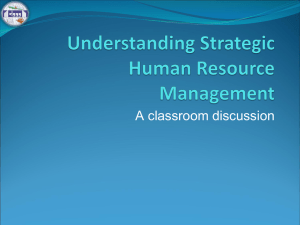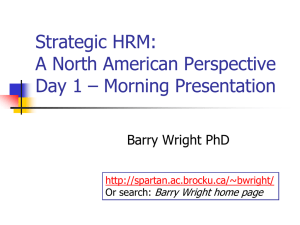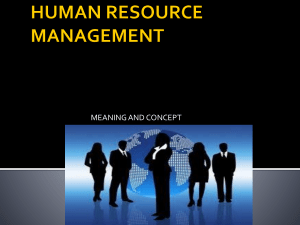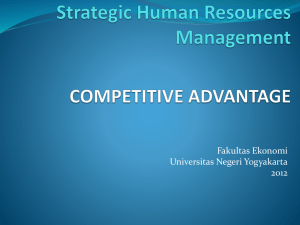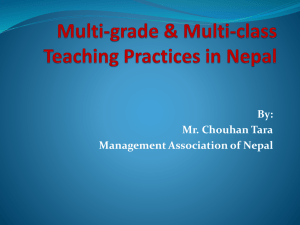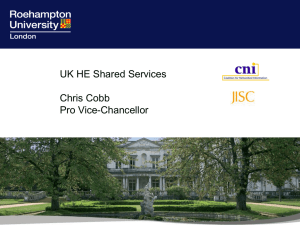企業績效
advertisement
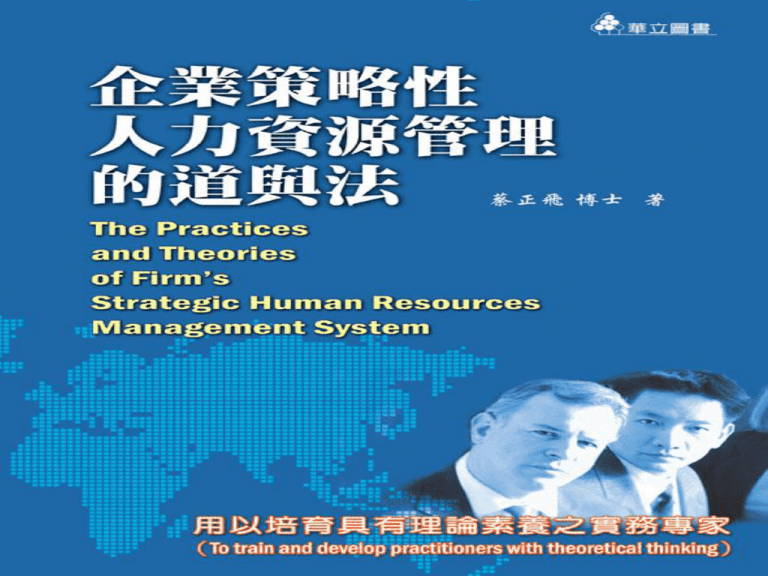
Chapter 1 策略性人力資源管理實務 概論 蔡正飛 博士 Dr. Philip TSAI 3 作者簡介 • 學歷 – 國立成功大學 企管系學士 – 國立中山大學 高階經營管理碩士 – 國立中山大學 人力資源管理博士 – 法國 里昂高等管理學院(EMLYON)進修 (2學期for國際企業管理) • 經歷 – MNCs: Capco (Amoco美商→bp英商 ),萬客隆Makro(荷 商),王安電腦 Wang(美商) , 聯亞電機 (美商GE)。 Wang – Local: 喬山健康科技 ,信孚交通器材, 新光紡織 。 – HRM, 生管、品管, Store general mgt., (前)中美和資深人力資源與社區關係經理 4 學術論文Academic publication record • • • • • • • • (2006). A Study on Motivating Employees’ Learning Commitment in Post-Downsizing Era: Job Satisfaction Perspective, Journal of World Business. SSCI (2006) An Empirical Research to Institutional Theory of Downsizing: Evidence on MNC’s Subsidiary Companies in Taiwan ,TQM& BE. SSCI (2005) An Empirical Test of Stakeholder Influence Strategies Model. International journal of HRM. SSCI (Also, one of the five yearly working papers in 2005 at Center of International Business & Research of Purdue University) (2005) Study of Remaining Employees’ Continuance Commitment after Downsizing. International journal of HR Development and management (2005)「企業人力精簡時員工的因應策略:企業利害關係人理論觀 點」,人力資源管理學報 (2003)「網際網路招募廣告內容之訴求--求職者觀點」, 人力資源管理學報 (2002) 「從交易成本理論探討暑期專案研究作為管理教育之產學合 作模式」,商管科技季刊 (2000)「中美合資公司的企業再造與人員精簡案」華人企業論壇 5 管理的核心價值 Core value of management 以倫理的態度,有效率及效果地使用資源 來創造利害關係人們作大的利益 Efficiently & effectively manage resources for creating maximum interest to firm stakeholders in ethic manner. ~ Philip TSAI 管理之 道 與法 “Do the right thing right” 6 價值鏈理論 Value chain theory 管理之法 - Michael Porter Activity of value chain ● 企業基礎建設(一般管理、法務、財務、策略計畫、資管…等) ●人力資源管理 ● 技術發展 ● 採購 設計 Design 低成本 Human Resource Management 作業(製造) Operation (manufacturing) Up steam Low cost ● : 支援性功能 行銷與銷售 Marketing & sales ← → 服務 Service 邊際利益 Margin Down steam 差異化 Differentiation 7 仗劍縱馬江湖行 實務的 Practical • 技能 Skills • 經驗 Experience vs 經典、理論 • 應變 Flexibility 執行力 + • 『道』 Value、Thinking • 『法』 System、Method & Tool 例: Ansel /外商HR prof ./ 本土 8 手中無劍 心中無劍 手中有劍 心中無劍 手中有劍 心中有劍 心劍合一 手中無劍 心中有劍 手中無劍 心中無劍 Green hands Clerk professional Dept. head Tacit Knowledge 退出江湖 9 炫麗的舞台 激情聲光 龐大樂團 曼妙舞群 陪襯合音 偶像狂熱迷 飛快節奏 耀眼服飾… 實力。 10 課程目的 & 綱要 一、人力資源管理之 道 二、人力資源管理之 法 1. 2. 3. 4. 5. 6. 心 劍 人力計畫 任用管理 教育訓練與發展 待遇管理 績效管理 勞資關係 實作s 11 策略性人力資源管理系統 經營策略 Strategies 所需職能 使命 理念 願景 MVV Competencies 職位說明書 人力計畫 Job description 招募與甄選 Workforce Planning Recruitment 經營 目標 教育與訓練 Education & training Goals 職涯管理 Career management 待遇與激勵 身心安康 Compensation Safety & Health 績效管理 Performance management 外部環境因素:政治、經濟、社會、國際…等 內部環境因素:公司政策、文化、勞資關係…等 12 Strategic Human Resources Management system 策略性人力資源管理系統 Strategies Competencies Mvv Workforce Planning Job Description & Qualification Recruitment Goals Education & Training Employee Career Mgt, Safety & Health Motivation (compensation) Performance Management Environment (Political、Economic、Social、International..) 、 Corporate policy、 Labor relationship.. Syste matic view 13 MVV- 心中的羅盤 •使命(Mission) -企業為何而在? 松下-帶給人們生活便利 迪斯尼- 帶給人們歡樂 玫琳.凱-創造女性無限機會 台灣自行車業:促進健康與休閒的產業 •願景(Vision) -未來展望 統一 :成為世界最大食品企業 (多少年內..) UPS:全球最大的快遞公司 •經營理念(Value) -共同的價值觀 日本航空:安全、真心的服務 玫琳.凱:品質、價值、便利、創新、顧客滿意 14 宋江經營『梁山泊』的 MVV 使命(Mission)-企業為何而在? 為何是 留名青史之英雄 好漢 而非 踞寨打劫之盜匪 強梁 ? -使落魄英雄好漢得以安身 立命;期待日後回歸主流。 願景(Vision) -未來展望 -有生之年梁山軍成為宋朝正規軍 ,有戰功;弟兄們能衣錦還鄉; 光宗耀祖。 經營理念(Value)- 共同的價值觀 -情義聚眾 -倫理(108:36+72) -忠君(能被招安) -正義(劫富濟貧) 過程是艱苦的甚至弟兄的不認同 15 Strategy planning process 策略規劃流程 - MVV與策略 使命 Mission 願景 Vision Review & Revise 外部 external 機會/威脅 (大環境/市場) 經營目標 Goal (中長期) 理念 Value 差異分析 現況Vs 顧客需求 , 顧客滿意 內部 Internal 強處/弱點 可行策略 Strategies 短期目標 Objectives↓ 行動計劃↓ Action plans 執行 Implement 競爭挑戰/ 限制條件 (資源/產品/核 心技術/績效..) SWOT分析 (Strength Weakness Opportunity Thread) 5 力分析 策略:政策與行動的型態(Mintzberg) 16 Forces Driving Industry Competition 5力 分析 (Michael Porter-整體競爭力評估 ) 比什麼? 存貨 管理 供應商的議價力 潛在進入者威脅力 產業內既有廠商 間的競爭力 技術面 資金面 購買者談判力 市場型態 價格 品質 時間、成本、品質、數量 替代產品的威脅力 技術面 價格 低成本(Low cost) 與 差異化(Differentiation)- Value to customers 競爭優勢(Competitive advantage) 17 企業命格 BCG Growth-Share Matrix 市場佔有率 明星 問題 預 期 成 長 率 金牛 狗狗 Ex.國營事業 企業”命位”會影響其經營策略之訂定,人資策略亦必隨之 18 企業(組織)生命週期 Corporate lifecycle – I. Adizes 是影響企業經營策略的另一重要變項,人資策略亦然 Maturity 繁榮 Rapid 成長 Nascent 停滯 Decline 衰退 組織業變革 (Change Mgt.) 轉機 危機 初創 Death Σ產品s(服務s) 敗亡 外部:環境的變化如政經環境、產品創新、市場整合… 內部:慣性變成惰性時 19 策略地圖-連結無形資產與股東價值 持久的股東價值 企業策略 生產力策略 改善成本 結構 財務觀點 收入成長策略 增加資產 利用 提昇顧客 價值 擴展營利 機會 顧客價值主張 顧客觀點 價格 品質 便利性 功能性 服務 產品/服務屬性 執行力 作業管理 生產與交貨 (內部效能) 產品與服務 觀點 內部程序 無形資產 如何切入 策略地圖 選擇性 顧客管理 提昇顧客價值 策略職類 (core workforce) 資訊科技 資產組合 關係 創新 創造新產品 與服務 組織改變 行事表 品牌 形象 法規面與社會面 改善社區與環境 創造協調一致與 準備就緒的程度 (Organization change agenda) 無形資產 學習與 ‧技巧 ‧系統 ‧文化 成長觀點 ‧訓練 ‧資料庫 ‧協調一致 ‧知識 ‧網路 ‧團隊合作 人力資本 夥伴關係 資訊資本 組織資本 ‧領導 20 The Strategy Map (Kaplan & Norton ,2004) Sustained Shareholder value Strategies Productivity Strategy Improve cost structure Financial perspective Increase assets utilization Revenue Growth Strategy Expand revenue opportunity Enhance customer value Customer Value Proposition Customer P. Execution Internal Process Perspective Price Quality Availability Selective Functionality (Dyn.Str.Cap.) Learning & Growth perspective Product/service attributes Operation Mgt. Produce & Deliver Product/ service How intangible assets fit into the Strategy map Service Partnership Customer Mgt. Enhance customer value Strategic job families Strategic IT portfolio Relationship Innovation Create new Product/ serv. Brand Image Regulatory & social Improve community & environment Organization change agenda (core workforce) Human capital Information cap. Organizational cap. ‧Skills ‧Systems ‧Culture ‧Leadership ‧Trainings ‧Databases ‧ Teamwork ‧Knowledge ‧Networks ‧ Alignment Creating alignment & Readiness HRM 21 Dynamic Strategic Capabilities (Organizational capabilities) are created from investing in HRM System (Ulrich & Smallwood,2004 ; Ulrich & Lake ,1991 ;Ulrich, 1987 ..) • • • • • • • • • • • 人才(talent)到位能力 速度(speed) 能力 共同的心態與一致的品牌認同(shared mind-set and coherent brand identity)能力 責任(accountability) 能力 合作(collaboration) 能力 學習(learning) 能力 領導(leadership) 能力 顧客連結(customer connectivity) 能力 策略統一(strategic unity) 能力 HRM system 創新(innovation) 能力 效率(efficiency) 能力 22 什麼是 “SHRM” ? • • • • • 80’s年代開始 將HRM系統中的HRM措施與企業績效的連結作 理論化的處理(Delery & Shaw, 2001) ; 需以策略性的(strategic)觀點來管理企業的人力資 源,才能創造企業的績效; 是企業競爭優勢的來源; 派別(Ferris, Hochwarter, Buckley, Harrell-Cook, & Frink, 1999) 單一措施的通用(普世)(universalistic); 因應特定組織策略而實施一些特定HRM措施的權變派 (contingency); 全形觀點派(configuration)跟權變派一樣,只能選用適 合組織策略的HRM措施, 但更強調這些HRM措施的垂直與水平之適配 。 23 策略與策略性人力資源管理整合圖 動態能力 人管措施 任用、 訓練、 工作設計、 參與、 報償、 績效考核 ..等. 改變 整合資源以調適或創造市場的作 業程序 更新 學習與創新 知識創 造 流量 知識移 轉 知識整 合 有價值 智慧資本 存量 系統 人 人力資 本 稀少 核心職能 能讓公司給 顧客提供 特別利益的 一組技巧與 技術。 是經由跨越 各種資源 學習而來。 難以模仿仿 社會資 本 組織資 本 組織 (Hamel & Prahalad, 1990) 資源基礎觀 資料來源:Wright, Dunford & Snell (2001:715) 24 競 爭 優 勢 Model of Integrating Strategy &Strategic HRM Renewal Learning and Innovation Flow Knowledge Creation Knowledge Transfer Knowledge Integration Valuable Intellectual Capital Systems Stock People Human People Capital Rare Inimitable Organized Social Capital Organization Capital : Yound, Subramaniam & Snell (2004) * : “Strategic” (Wright, 2002) (RBV) Core Competence Valuable Knowledge ...a bundle of skills and technologies that enables a company to provide a particular benefit to customers. It represents the sum of learning across these resources. ( Hamel & Prahalad) Change Competitive Advantage Staffing, training, work design, participation, rewards, appraisal, etc. Dynamic* Capabilities Processes to integrate, reconfigure, gain, and release resources—to match and even create market change. Firm Performance People Management Practices (Wright, Dunford & Snell, 2001 ) Porter,1991 25 職能/才能/專長 (Competencies) 一個人(組織)在特定的工作、角色、組織 或文化中所表現出來之績效的特質 技能 知識 特質 動機 外顯的 自我形象 內隱的 Dr. David McClelland, Harvard University 26 職能種類 專業職能 •IT •化工 •機械 •儀電 •財務會計 •HR •… 共用職能 •團隊合作 •顧客導向 •組織承諾 •分析性思考 •結果導向 •創造價值 管理職能 •團隊領導 •發展員工 •………… •….. 核心職能 27 SHRM 的理論架構 Wright & McMaham , 1992 “Theoretical prospectives for SHRM” Journal of Mgt, 18(2) + Zivnuska, Ketchen & Snow 2001 Research in Pnl & HRM vol.20 企業策略 (生態進化面) 企業資源 基礎觀 體制與政治力量 HRM措施 (Barnney,1991) 資源依賴理論 體制化理論 •企業倫理 -重視員工“工作之意義”vs 只 重績效 系統理論* :延伸出控制理論 - 重視員工情緒 (經濟面) 行為學派 代理與 交易成本理論 _ •人口生態 •組織學習 •威脅-僵化 人力 資本 _ 企業策略 員工行為 (個人層次的成果) 人管措施 企業績效 (企業層次的成果) 企業績效 28 New definition for SHRM - Philip Cheng-Fei TSAI “One set of specific human resource management practices for enhancing firm’s dynamic strategic capabilities.” “一組強化企業動態策略能力的人力資源管理措施” 29 SHRM Focus (實務趨勢) • 變革管理與文化創新 (Culture change & BPR) – 含購併管理與人員精簡 (Mergers & Downsizing) • • • • • • • • • 核心專長導向管理 組織發展與團隊管理 知識管理與組織學習 績效評估與改善 社會網絡管理 學習科技與數位學習 員工轉型行為管理 發展管理與領導才能 國際化及跨文化管理 (Core competencies) (Team Mgt.) (KM & organizational learning) (Performance Management) (Social Network) (e-learning) 智慧資本 管理 (Transformational behavior) (Development mgt.) (Globalization & Multi-culturemgt.) 30 HRM專業人員職能之改變 - SHRM perspective 前瞻才能 (Leadership) 人資知能 (技巧與知識) 甄選人才/薪資管理/ 教育訓練/ 績效考核/ 勞資關係... MVV /公司文化/ 變革管理 /團隊建立 /國際觀…. 事業經營才能 (Business Strategy) 產業知識 經營管理 策略性思維 基本才能:溝通表達; 談判協商; 輔導諮商 ;問題處理 31 教科書/參考書 老師提供的講義之外 Human resources Management, Dessler, 2005, 10 版 Pearson, (華泰書局代理) 人力資源管理, 黃英忠, 2003, 2 版, 三民書局 專業的甄選面談術, 蔡正飛, 2006, 1 版, 汎果文化 Strategic human resources: Frameworks for General Managers , Baron & Kreps, 1999 , Wiley 上課方式 碩士班:一週老師講解,一週學生小組報告。 32 Human Resource Management in Action Action assignment 作業 分組,每組4~5人 HRM在貴公司的角色 為何 ? 有那些地方可做得更好? 33 謝謝 !! & Good luck 34
